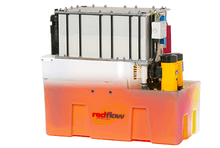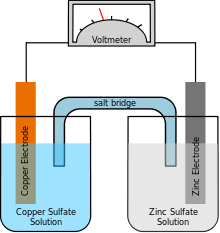Zinc–bromine battery
| Specific energy | 34.4–54 W·h/kg (124–190 J/g) |
|---|---|
| Energy density | 15.7–39 W·h/L (56.5–140 kJ/L) |
| Charge/discharge efficiency | 75.9%[1] |
| Energy/consumer-price | US$400/kW·h (US$0.11/kJ) |
| Cycle durability | >2,000 cycles |
| Nominal cell voltage | 1.8 V |
The zinc–bromine flow battery is a type of hybrid flow battery. A solution of zinc bromide is stored in two tanks. When the battery is charged or discharged the solutions (electrolytes) are pumped through a reactor stack and back into the tanks. One tank is used to store the electrolyte for the positive electrode reactions and the other for the negative. Zinc bromine batteries from different manufacturers have energy densities ranging from 34.4–54 W·h/kg.
The predominantly aqueous electrolyte is composed of zinc bromide salt dissolved in water. During charge, metallic zinc is plated from the electrolyte solution onto the negative electrode surfaces in the cell stacks. Bromide is converted to bromine at the positive electrode surface and is stored in a safe, chemically complexed organic phase in the electrolyte tank. Each high-density polyethylene (HDPE) cell stack has up to 60 bipolar, plastic electrodes between a pair of anode and cathode end blocks.
The zinc–bromine battery can be regarded as an electroplating machine. During charging zinc is electroplated onto conductive electrodes, while at the same time bromine is formed. On discharge the reverse process occurs, the metallic zinc plated on the negative electrodes dissolves in the electrolyte and is available to be plated again at the next charge cycle. It can be left fully discharged indefinitely without damage.

The primary features of the zinc bromine battery are:
- High energy density relative to lead–acid batteries
- 100% depth of discharge capability on a daily basis[2]
- No shelf life limitations as zinc–bromine batteries are non-perishable, unlike lead–acid and lithium-ion batteries, for example.[2]
- Scalable capacities
Drawbacks include:
- The need to be fully discharged every few days to prevent zinc dendrites that can puncture the separator[2]
- The need every 1-4 cycles to short the terminals across a low impedance shunt while running the electrolyte pump, to fully remove zinc from battery plates[2]
- Low areal power (<0.2 W/cm2) during both charge and discharge which translates into a high cost of power.[3][4][5]
Zinc–bromine flow battery providers include:
- Primus Power - Hayward, California, USA
- RedFlow Limited - Brisbane, Australia
- Smart Energy - Shanghai, China
- ZBB Energy Corporation - Menomonee Falls, Wisconsin, USA
- ZBEST Power - Beijing, China
These battery systems compete to provide energy storage solutions at a lower overall cost than other energy storage systems such as lead-acid, vanadium redox, sodium–sulfur, lithium-ion and others.
Electrochemistry
At the negative electrode zinc is the electroactive species. Zinc has long been used as the negative electrode of primary cells. It is a widely available, relatively inexpensive metal which is electronegative, with a standard reduction potential, E° = −0.76 V vs SHE. However, it is rather stable in contact with neutral and alkaline aqueous solutions. For this reason it is used today in zinc–carbon and alkaline primaries.
In the zinc–bromine flow battery the negative electrode reaction is the reversible dissolution/ plating of zinc, according to the following equation.
At the positive electrode bromine is reversibly reduced to bromide, (with a standard reduction potential of +1.087 V vs SHE) according to the following equation.
The overall cell reaction is therefore.
The measured potential difference is around 1.67 V per cell (slightly less than that predicted from the standard reduction potentials).
The two electrode chambers of each cell are divided by a membrane (typically a microporous or ion-exchange variety). This helps to prevent bromine from reaching the positive electrode, where it would react with the zinc, causing the battery to self-discharge. To further reduce self-discharge and to reduce the vapor pressure of bromine, complexing agents are added to the positive electrolyte. These react reversibly with the bromine to form an oily red liquid and reduce the Br
2 concentration in the electrolyte.
Applications
Remote telecom sites
Significant fuel savings are possible at remote telecom sites operating under conditions of low electrical load and large installed generation using multiple systems in parallel to maximize the benefits and minimize the drawbacks of the technology.[6]
References
- ↑ "Performance Testing of Zinc-Bromine Flow Batteries for Remote Telecom Sites" (PDF). Sandia National Laboratories. 2013. p. 6. Retrieved 2015-04-01.
- 1 2 3 4 Rose & Ferreira, p. 4.
- ↑ G.P. Corey, An Assessment of the State of the Zinc-Bromine Battery Development Effort RedFlowLimited Brisbane, Queensland, Australia, 2011.
- ↑ Nakatsuji-Mather, M.; Saha, T. K. (2012). "Zinc-bromine flow batteries in residential electricity supply: Two case studies": 1–8. doi:10.1109/PESGM.2012.6344777.
- ↑ Suresh, S.; Kesavan, T.; Munaiah, Y.; Arulraj, I.; Dheenadayalan, S.; Ragupathy, P. (2014). "Zinc–bromine hybrid flow battery: effect of zinc utilization and performance characteristics". RSC Advances. 4 (71): 37947. doi:10.1039/C4RA05946H. ISSN 2046-2069.
- ↑ Rose & Ferreira, p. 10.
Further reading
- Bromine Complexation in Zinc–Bromine Circulating Batteries D. J. Eustace, J. Electrochem. Soc. 127(3), 528–32 (1980)
- Handbook of batteries, 3rd edition. D. Linden, T. B. Reddy. 39.1–39.8 (2002)
- Rose, David M.; Ferreira, Summer R. "Performance Testing of Zinc-Bromine Flow Batteries for Remote Telecom Sites" (PDF). Sandia National Laboratory.
- RedFlow.
External links
- RedFlow Limited
- Smart Energy
- ZBB Energy
- ZBEST Power
- Primus Power
- ZnBr Batteries at the Electricity Storage Association
